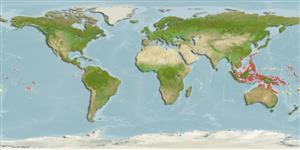Teleostei (teleosts) >
Gobiiformes (Gobies) >
Gobiidae (Gobies) > Gobionellinae
Etymology: Hemigobius: Greek, hemi = half + Latin, gobius = gudgeon (Ref. 45335).
More on author: Bleeker.
Environment: milieu / climate zone / depth range / distribution range
Ecology
Marine; freshwater; brackish; demersal; amphidromous (Ref. 46888); depth range 0 - 5 m (Ref. 86942). Tropical
Western Pacific: Thailand, Hong Kong, Malaysia, Singapore, Philippines, Borneo, New Guinea and northern Australia.
Size / Weight / Age
Maturity: Lm ? range ? - ? cm
Max length : 6.0 cm TL male/unsexed; (Ref. 7050)
Dorsal
spines
(total): 7;
Dorsal
soft rays
(total): 7-8;
Anal
spines: 1;
Anal
soft rays: 7 - 9;
Vertebrae: 26 - 27. Body robust, compressed, with rounded somewhat depressed head, snout rounded and overhanging upper lip; longitudinal scales 27-32; anteriormost predorsal scale largest, 8-10 scales, extending close up behind eyes; mouth enlarged in males; scales on body ctenoid; first dorsal fin low, rounded, with no filamentous spines; body greyish to brownish with six diagonal blackish bars across sides, marbled to ocellate black spot on caudal base, roughly vertical black spot on caudal base, roughly vertical black line on opercle extending to underneath head (Ref. 44011). Caudal fin rounded (Ref. 44011).
Inhabit mangrove estuaries and streams, usually under leaf litter and detritus (Ref. 44011).
Life cycle and mating behavior
Maturity | Reproduction | Spawning | Eggs | Fecundity | Larvae
Larson, H.K., 1999. A review of the mangrove goby genus Hemigobius (Gobioidei, Gobiidae, Gobionellinae). Beagle, Rec. Mus. Art Galler. North.Territ.15:23-42. (Ref. 44011)
IUCN Red List Status (Ref. 130435)
Threat to humans
Harmless
Human uses
Fisheries: of no interest
More information
Common namesSynonymsMetabolismPredatorsEcotoxicologyReproductionMaturitySpawningSpawning aggregationFecundityEggsEgg development
ReferencesAquacultureAquaculture profileStrainsGeneticsElectrophoresesHeritabilityDiseasesProcessingNutrientsMass conversion
Tools
Special reports
Download XML
Internet sources
Estimates based on models
Preferred temperature (Ref.
123201): 26.2 - 29.3, mean 28.7 °C (based on 1931 cells).
Phylogenetic diversity index (Ref.
82804): PD
50 = 0.7500 [Uniqueness, from 0.5 = low to 2.0 = high].
Bayesian length-weight: a=0.00724 (0.00338 - 0.01553), b=3.05 (2.87 - 3.23), in cm total length, based on LWR estimates for this (Sub)family-body shape (Ref.
93245).
Trophic level (Ref.
69278): 3.3 ±0.4 se; based on size and trophs of closest relatives
Resilience (Ref.
120179): High, minimum population doubling time less than 15 months (Preliminary K or Fecundity.).
Fishing Vulnerability (Ref.
59153): Low vulnerability (10 of 100).
